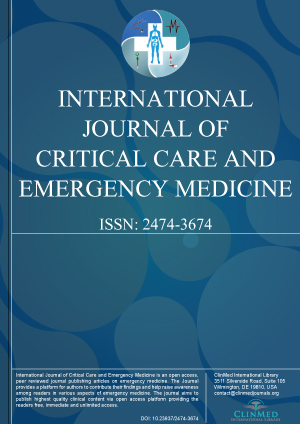Archive
Open Access DOI:10.23937/2474-3674/1510069
Kristin Schwab, MD, Jodi Friedman, MD, Michael E Lazarus, MD and Jason P Williams, MD
Article Type: Brief Report | First Published: February 16, 2019
Article Formats
- Abstract
- Full Article
- XML
- EPub Reader
Open Access DOI:10.23937/2474-3674/1510068
What Statistics do Emergency Physicians Need to Know
Edward A Ramoska, MD, MPH*, Virat Patel, MD, Alin Gragossian, DO and Romy Nocera, PhD
Article Type: Original Article | First Published: February 14, 2019
Article Formats
- Abstract
- Full Article
- XML
- EPub Reader
Open Access DOI:10.23937/2474-3674/1510067
Use of Programmed Multilevel Ventilation as a Superior Method for Lung Recruitment in Heart Surgery
Peter Candik, Adrian Kolesar, Martin Nosal, Matus Pauliny, Frantisek Sabol, Viera Donicova, Viliam Donic and Pavol Torok
Article Type: Original Article | First Published: January 26, 2019
Article Formats
- Abstract
- Full Article
- XML
- EPub Reader
Open Access DOI:10.23937/2474-3674/1510066
Altruism: Brief Review of Current Opinions and Implications on Community Emergency Medicine
Oshionwu EJ and Nwose EU
Article Type: Commentary | First Published: January 25, 2019
Article Formats
- Abstract
- Full Article
- XML
- EPub Reader
Open Access DOI:10.23937/2474-3674/1510065
Predictors of Adverse Outcome Early After ICU Discharge
Katsiari M, Ntorlis K, Mathas C and Nikolaou C
Article Type: Original Article | First Published: January 07, 2018
Article Formats
- Abstract
- Full Article
- XML
- EPub Reader
Open Access DOI:10.23937/2474-3674/1510064
Harish Venkatesh, Sanjeev Ramachandran, Atanu Basu and Hari Nair
Article Type: Case Report | First Published: January 05, 2019
Article Formats
- Full Article
- XML
- EPub Reader
Open Access DOI:10.23937/2474-3674/1510063
An Exploratory Study of Overnight Education in the Medical Intensive Care Unit
Camille R Petri, Brittany L Ranchoff, Amy P Cohen, Amy M Sullivan, Richard M Schwartzstein and Margaret M Hayes
Article Type: Brief Report | First Published: January 04, 2019
Article Formats
- Abstract
- Full Article
- XML
- EPub Reader
Open Access DOI:10.23937/2474-3674/1510062
Koh Nan Jun, Quek Hui Yu and Lateef F
Article Type: Review Article | First Published: January 03, 2019
Article Formats
- Abstract
- Full Article
- XML
- EPub Reader
Open Access DOI:10.23937/2474-3674/1510061
Efficacy of Cervical Immobilization in Multiple Trauma Patients
S Cacho Garcia, D Pena Otero and M Eguillor Mutiloa
Article Type: Review Article | First Published: January 03, 2019
Article Formats
- Abstract
- Full Article
- XML
- EPub Reader

Volume 5
Issue 1
Issue 1
